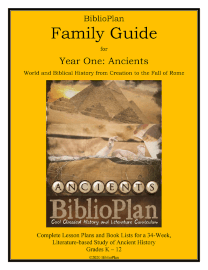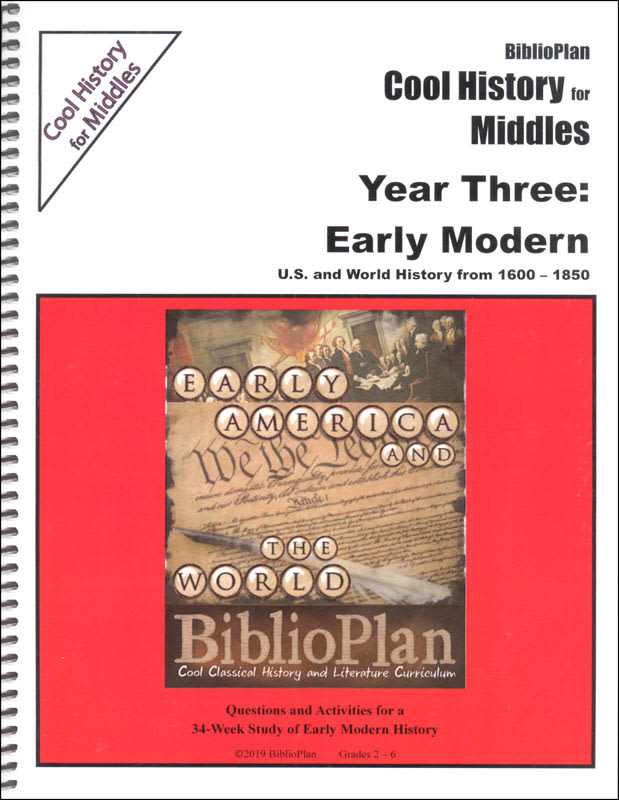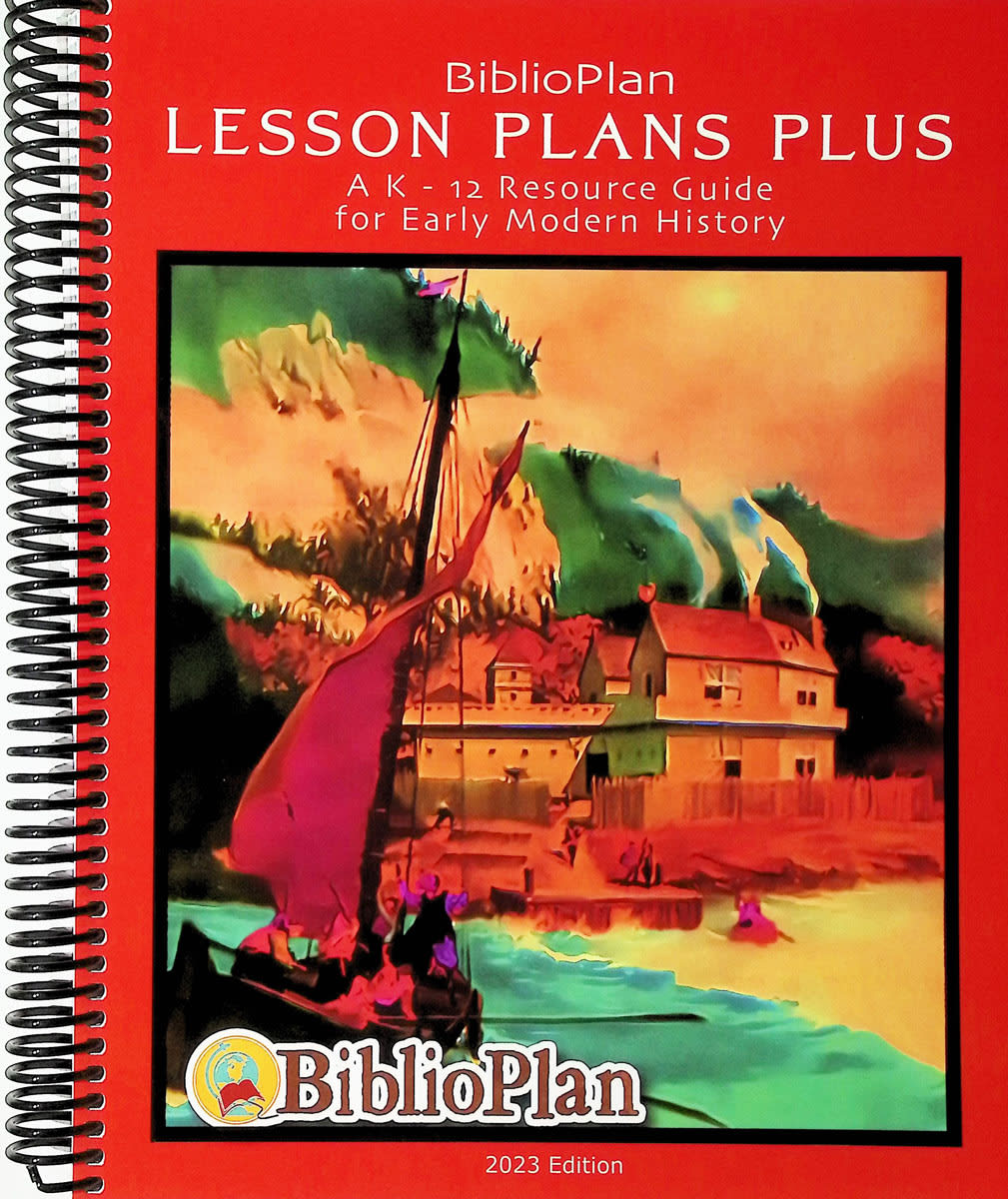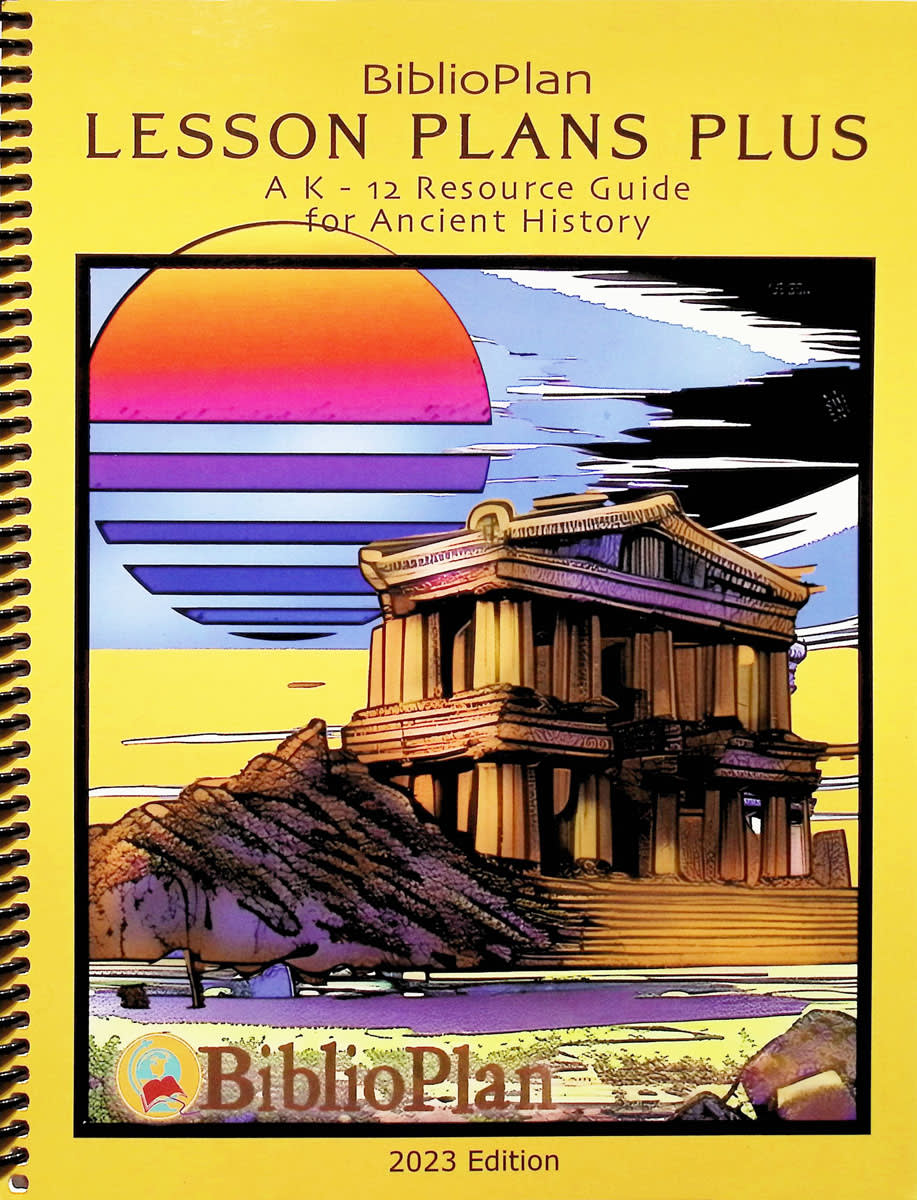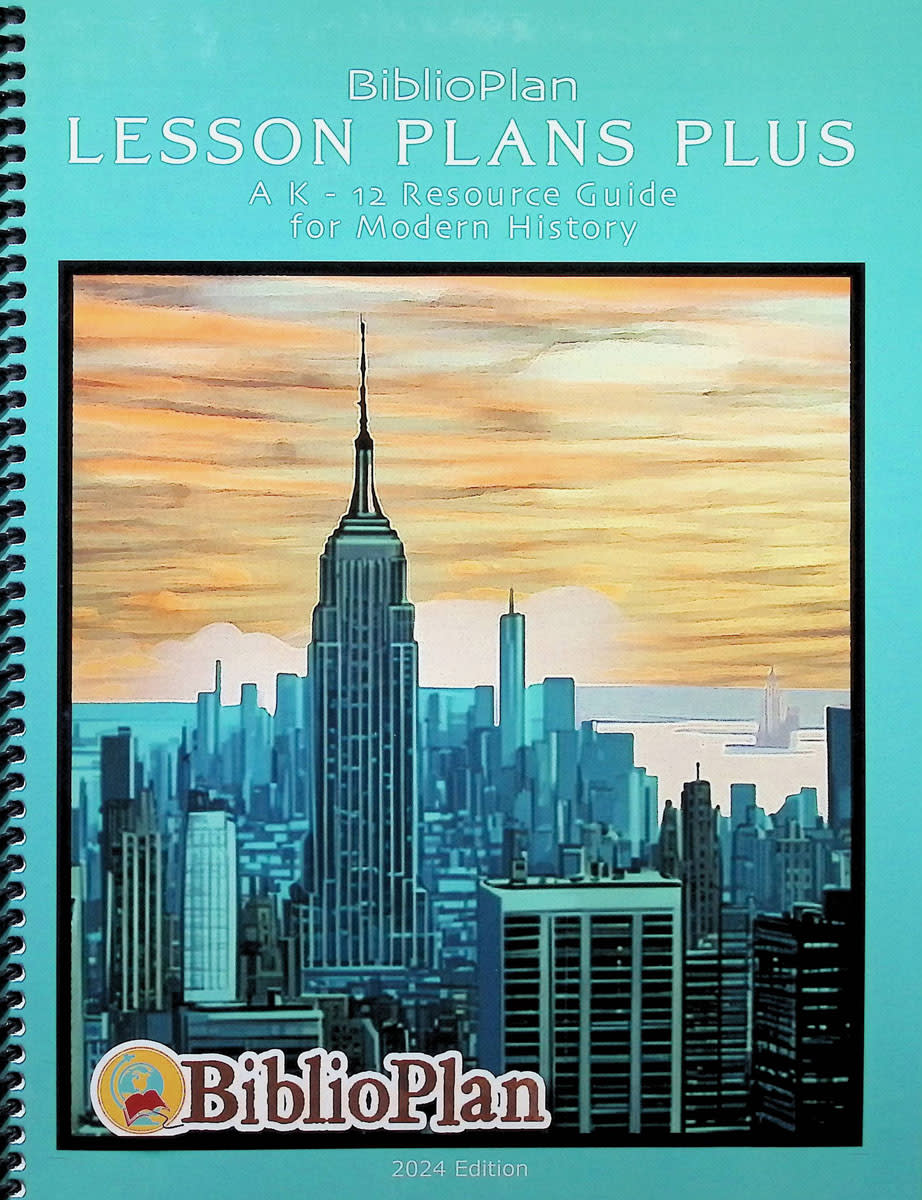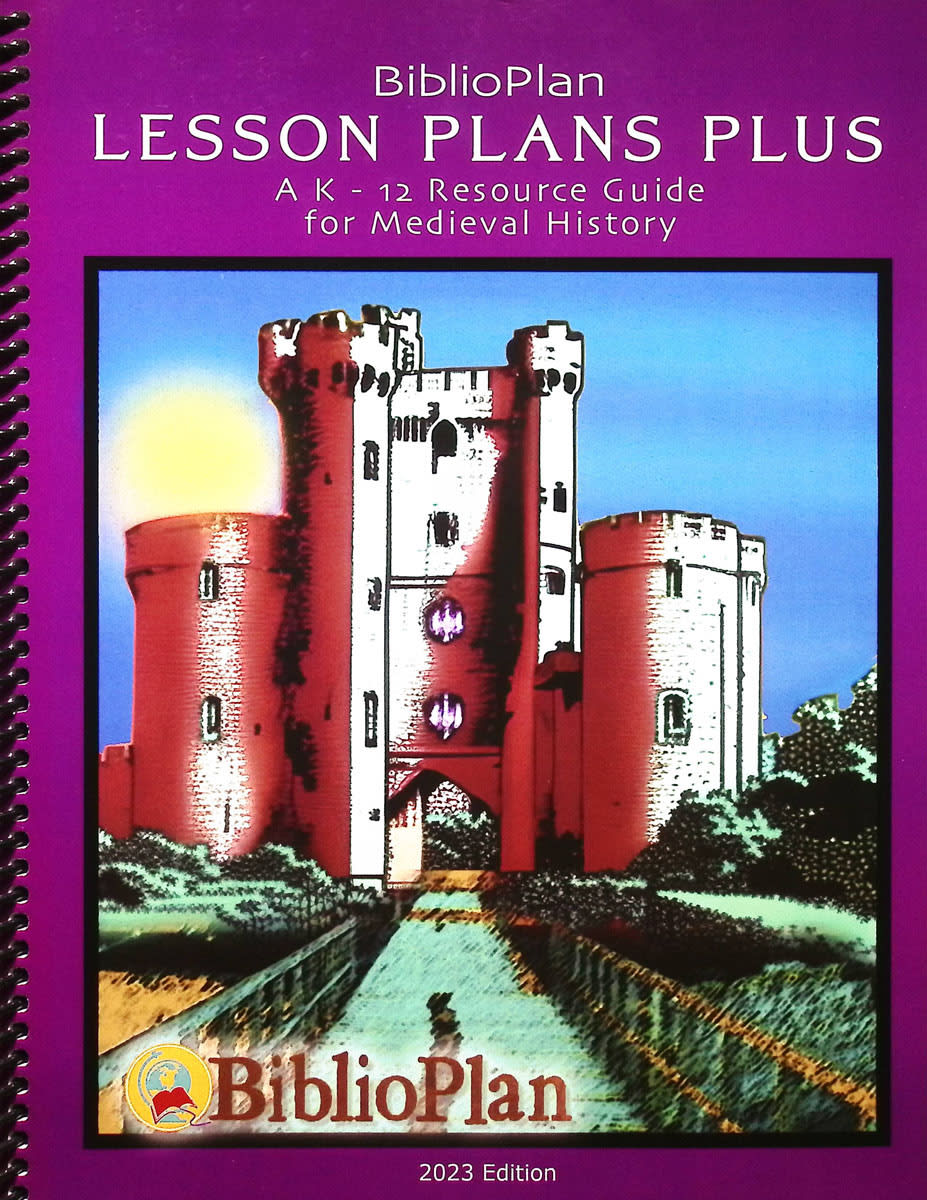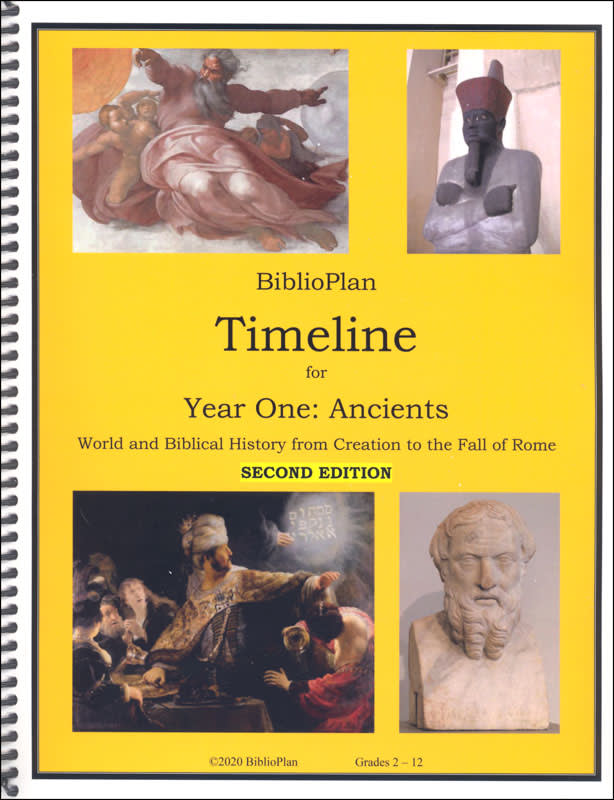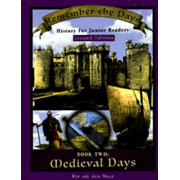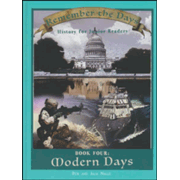BiblioPlan offers a unique approach for teaching history to children at all grade levels together. BiblioPlan courses teach from a biblical Christian (Protestant) worldview, although not all resources used within the program do so. It accomplishes this by presenting the same general topics to all students while using resources and activities suitable for various levels.
BiblioPlan identifies itself as a classical program, so it presents material at levels appropriate for the grammar, dialectic, and rhetoric stages. It uses the same chronological time divisions for history as does Susan Wise Bauer in The Story of the World series. It also has some elements of Charlotte Mason's approach, particularly in its use of "living books."
While the primary focus is history, students do significant work in geography as well as reading and writing (more as they shift to upper grades), enough so that they should also receive at least partial course credits for literature and geography, and possibly for composition.
The Bible is used heavily in the first BiblioPlan to teach both biblical history and knowledge of scripture itself. Church history is covered extensively in the second course. Subsequent courses feature biographies of significant Christians—“giants of the faith” —within each historical period and geographical area. So BiblioPlan will also provide either partial or full coverage of religion for each school year. A chart in the introductory pages of each Family or Teacher's Guide shows high school credits that might be assigned for each course.
There are four core courses for BiblioPlan:
- Ancients, which covers Creation to the Fall of Rome
- Medieval, which covers the Fall of Rome to the Renaissance (Note: while the focus is primarily on western civilization, this course does cover Asia, Africa, and the Americas prior to Columbus, as well as Islam.)
- Early Modern, which covers both American and World history from 1600-1850
- Modern, which covers both American and World history from 1850-2000 (Note: this course has a slightly conservative political slant.)
You can begin teaching a student in BiblioPlan at any level, beginning with whichever of the four courses addresses the time period you want to cover. However, you should have the entire family working from the same BiblioPlan course each year.
BiblioPlan has made it easier to stretch these courses across the span of kindergarten through high school by creating two series of spine resources that present the historical and biblical information at younger or older levels. Remember the Days (RTD) is a series of four books that can be used with children from kindergarten through eighth grade. Students from sixth through twelfth grade can use one of the four BiblioPlan Companions (BPC) instead. (There's an overlap that gives you the freedom to use either resource for students in grades six and eight.) If you are teaching only children in seventh grade or below, you can use RTD with all of them. If you have only students in sixth grade or above, you should probably go with the BPC. If you have both older and younger children you can read aloud (if necessary) from RTD with younger students while older students read the BPC on their own.
You should cycle through these four courses with your children, shifting them up to higher levels the next time (or even a third time) around. Selecting the activities and readings for a higher level each time keeps the material fresh and age-appropriate.
BiblioPlan courses are written from a Protestant worldview. The authors assume that history, as presented in the Bible, is true, so they base a significant amount of coverage on biblical information in the first course. They most strongly support a young-earth, creationist perspective, but they bring up beliefs widely held by other Christians. For instance, while they discuss Archbishop James Ussher's young-earth chronology in Consider the Years - Book One: Ancient Years, they also raise some of the challenges that chronology faces.
Components
The core components of each BiblioPlan course are the BiblioPlan Family Guide and either Remembering the Days (RTD) or the BiblioPlan Companion (BPC), as I explained previously. These are available in printed books or as PDFs. RTDs and BPCs are similar to textbooks with readings, background information, biographical sketches, images, and maps. None of them have questions or assignments since those are found in the other BiblioPlan resources. Either the RTD or the BPC volume for the time period to be studied serves as your primary book for history content. Assignments for readings in both books are laid out in the weekly plans in the corresponding BiblioPlan Family Guide.
Within each BiblioPlan Family Guide is a set of two-page, weekly lesson plans for 34 weeks. The lesson plans chart out which pages of which BiblioPlan resources are to be used on a three-day per week schedule. The schedule also has rows listing specific assignments for Bible reading, plus reading from optional history or Bible resources for the different age levels.
The weekly lesson plan charts in the Family Guides also include lists of possible literature selections for four levels, family read-aloud recommendations, and writing assignments. Writing assignments are designated for three different levels: young writer, grammar, and logic levels. Writing assignments for the rhetoric level are in the Advanced Cool History books. Another section of the lesson plan lists hands-on activities using optional BiblioPlan products such as the Hands-on Maps, Discussion Guide, timeline work, coloring pages, and crafts. The last section of each week's lesson plan lists optional video and audio resources, specific cards from Veritas Press' and Classical Conversation's history card sets, and other supplemental books and resources such as the Famous Figures (movable figures) series and History Pockets series (activity books).
The Family Guide for each course recommends optional history books that you might choose to read from along with readings from RTD or the BPC. With younger students, you are already likely to have too much content rather than not enough. Examples of some of the suggested supplementary history books for which BiblioPlan provides assignments are The Story of the World, Mystery of History, Streams of Civilization, History of US, Story of Civilization (a Catholic option listed only for RTD: Ancient Days thus far), Victor Journey through the Bible, Usborne Internet‐linked Encyclopedia of World History, and Trial and Triumph. The Family Guides tell you the grade levels for which each is appropriate.
Each course lists optional historical literature—living books—including some titles related to Bible and church history. BiblioPlan courses differ from similar programs since they recommend many literature selections for supplemental reading but do not require specific books. Parents can choose titles that place more emphasis on particular topics this way. Annotated literature recommendations for each unit are included in the Family Guides. Literature lists include descriptions of the books, suggested age ranges, and the number of pages for each book. These descriptions are very helpful since you need to choose from among many options. For families who are overwhelmed with the number of BiblioPlan's literature selections, they identify "Quick Picks," the books they consider the best for each unit and grade level.
Remember the Years
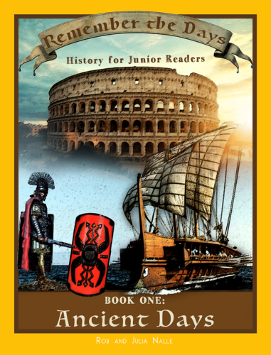 The RTD volumes each have more than 350 pages and are written at about a fourth- and fifth-grade reading level. They provide more history content than you need for students in kindergarten through second grade. Each RTD volume focuses on two areas of history and clearly labels sections as to which is being covered. For instance, RTD: Ancient Days covers biblical history and world history. With young students, you might choose to use only biblical or only world history from that volume. In succeeding volumes, you can choose between church history, world history, and U.S. history.
The RTD volumes each have more than 350 pages and are written at about a fourth- and fifth-grade reading level. They provide more history content than you need for students in kindergarten through second grade. Each RTD volume focuses on two areas of history and clearly labels sections as to which is being covered. For instance, RTD: Ancient Days covers biblical history and world history. With young students, you might choose to use only biblical or only world history from that volume. In succeeding volumes, you can choose between church history, world history, and U.S. history.
As students get older, you might use more supplemental books for history coverage to expand upon what is included in RTD. For instance, both RTD: Early Modern Days and RTD: Modern Days cover world history and United States history, Nevertheless, you might want more coverage of one area or the other in a particular year. You also might want to add the study of your state's history.
Within both the RTDs and BPCs, geography is integrated at points where it connects with history. So students learn geography in context, an approach that I think works better than teaching geography on its own. The geography is supported by map work activities in the supplemental Hands-On Maps book for each course I describe below. World geography is taught in the first two volumes and U.S. geography in the second two.
BiblioPlan Companions or Consider the Years
When I first reviewed the BiblioPlan Companions, I was struck by their breadth and depth of content, as well as the wealth of images and maps. In comparison to the RTD books, more information is presented under bullet points than in connected paragraphs, which is a bit different than most textbooks. Sections printed in black-and-white cover the basic narrative and timeline. Sections with colored backgrounds (which occur frequently) cover biographies and other special topics. Division of the content into the various sections breaks up the reading into more manageable chunks, and not all of the chunks are essential. This is important since the BiblioPlan Companions are lengthy books; Ancients has 354 pages, Medieval has 747 pages, Early Modern has 864 pages, and Modern has 588 pages! While students in sixth grade and above should read all of Ancients, those below high school level might skip some sections in the other volumes to keep the amount of reading manageable.
BiblioPlan has published the first volume of Consider the Years, a series that will eventually replace the BiblioPlan Companions. Consider the Years is a greatly expanded version of the BPC, still including both history and geography. The first volume, Consider the Years - Book One: Ancient Years is more than twice as long as the BPC it replaces. The additional content in this volume provides more historical detail, images, and in-depth discussion of biblical topics. For instance, the entire first chapter in Consider the Years (CTY) is about creation and the fall of mankind, while the original BPC summarized creation in half a page and didn't discuss Adam and Eve at all.
CTY breaks up the text with witty headings and frequent color blocks to make the text more readable, but it doesn't have color-coded sections like BPCs. Vocabulary words are in bold with definitions in sidebars. I would recommend CTY for high school students. Those in middle school should generally use Remember the Days, at least for Ancients. CTY for Modern years is scheduled for availability in early 2023, with the other two volumes to follow later.
Supplements
In addition to the Family Guide and either the RTD or BPC (or CTY) for each course, you will need other resources depending upon the grade levels you are teaching. You will need to purchase these resources for each level of BiblioPlan. Some are essential and a few are optional. Permission is given to reproduce pages of the following supplements for use within your family.
Cool History: These four essential books have assignments specific to each level. You need to purchase only the level(s) needed for your children. Choose from four levels: Littles (K-2), Middles (grades 2-6), Upper Middles (grades 6-8), and Advanced (grades 9-12).
A fifth option is also available for those who want to use Susan Wise Bauer's Story of the World. Cool History Classics draw questions from both the RTD volume and the Story of the World volume. A single Cool History Classics for each volume of BiblioPlan targets grades one through six. You would choose this in place of another Cool History if you know that you want to incorporate Story of the World as a supplement.
In each Cool History, there is approximately one worksheet per week plus occasional supporting activity pages. While all levels have questions on the reading, other activities vary depending upon the level. For example, Littles have coloring activities. Littles and Middles have hands-on activities. Both Middles and Upper Middles start children into research activities, and Advanced requires students to do significant research and essay writing. Examinations are included in the two upper levels. Answer keys are included at the end of each book.
Hands-on Maps: These workbooks have map work and geography activities that correlate directly with each BiblioPlan course. There are one or two pages per week to be completed. Work is primarily labeling and coloring, but sometimes students are asked to draw in boundary lines and geographical features. Reviews and exams are included. They are available for two levels, Middles (grades 2-7) and Advanced (grades 7-12). Students at the younger levels should be given only selected assignments from the Middles book, and they will require parental assistance. By fifth grade, students should be able to complete map work independently.
Discussion Guide: The Discussion Guides are essential for those using a BPC or CTY with older students, and they are optional for those using RTDs with students in grades six through eight. The guides provide key points to review and discuss with children as well as a range of questions for discussion. Some questions are designed to develop a Christian worldview. Parents should pick and choose the questions most appropriate for their children. Parents need to be familiar with the material in the BPC or CTY since questions are based on its content.
Timeline: A Timeline book for each BiblioPlan includes pictures of people, places, and events that are printed in full color. These are a mixture of reproductions of artwork (especially portraits), drawings, photographs, drawn figures, and flags. The timeline itself consists of many pages that can be mounted on a wall or put into a notebook. (These take up a great deal of wall space!) The timeline pages show where figures are to be mounted and include descriptive text. Unless you have a high-quality color printer, you might want to purchase the print edition of this book rather than print it out yourself. The Timeline books can be used for all ages.
Coloring Book: A coloring book for each BiblioPlan has more than 80 pages with detailed drawings of key figures or events. While these are ideal for kindergartners through second graders, students of all ages might enjoy using them.
Craft Book: Craft Books for the first three BiblioPlan courses have a number of activities for each unit. For example, when students are studying the Roman Empire, they might make a banner, hold a mock chariot race, dress up like roman citizens (and have a Roman feast), or make a Roman warrior’s equipment. For some projects, you’ll need craft materials like a hot glue gun, paint, felt, pipe cleaners, and poster board as well as some unusual items like a ceramic flower pot. Craft books are best for students up through sixth or seventh grade. Hands-On Modern History: Learning Culture Through Crafts, Food, and Fun offers a broader range of activities for the fourth course with options for all ages.
BiblioPlan Notebooking: Hands-On Asia, Hands-On Europe, Hands-On Americas, and Hands-On Africa have notebooking pages to be used with the four courses, respectively. Hands-On Presidents and Hands-On States can be used along with both Early Modern and Modern courses. Notebooking resources are only available as PDFs and are recommended for grades two through twelve.
Co-ops or Christian School Classes Teacher's Guide: BiblioPlan has created a special teacher’s guide for those teaching co-op classes or in Christian schools. The teacher’s guide for each BiblioPlan course provides very detailed instructions for teaching same-age or multi-age groups. Group class teachers would use this guide rather than the Family Guide. Teachers would also not need the Family Discussion Guide.
BP Tips and Tricks: Biblioplan is already very flexible, but this PDF offers suggestions for adapting for both struggling and gifted learners.
Online and Self-Paced Courses
Biblioplan offers live, online courses for selected Bibioplan courses and particular grade levels that are taught by course author Julia Nalle and others. Biblioplan is also just beginning to offer self-paced courses. These are online, recorded courses that students can work through on their own schedule. Check the website for current course availability.
Summary
All of these resources work together to make it easy for both parents and teachers to present history in a far more interesting fashion than traditional textbooks.
BiblioPlan resources are available as ebooks or in printed hard copies, with substantial savings on ebook versions. Sample pages from the various resources as well as all of the options for purchasing bundles, print, or ebooks are available on the publisher's website. You can also download free, three-week samples of all four courses at the publisher's website so you can check it out before buying.




